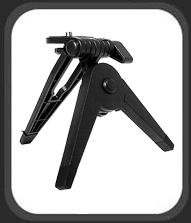Rechargeable Batteries:
Many cameras come with rechargeable batteries included, which can make life much easier (and less expensive). Cameras can drain batteries quickly thanks to the larger, color LCD screens that they now need to power, as well as the flash and the other usual functions.
If a camera does come with rechargeable batteries, it may be worth investigating whether or not it uses a proprietary format, or one of the more common battery types (like AA or AAA). Proprietary batteries may have their advantages, but in general, a camera that accepts a commonly available battery may be the most convenient for two reasons:
First, if the rechargeable batteries should happen to run out of charge and you have neither the time nor facilities to recharge them, you can easily pop in common disposable batteries just to keep the camera up and running. This may prove to be particularly helpful while traveling when there is either no outlet for recharging, or you only have access to a foreign power source which requires an adaptor you don't happen to have.
Secondly, the benefit of using a standard battery type comes when the batteries eventually die all together. Rechargeable batteries can only be charged so many times, and as they age, their performance may begin to fade before they die all together. Replacing batteries of a standard format is easy and relatively inexpensive, while sourcing a replacement proprietary battery may be much more difficult and much more expensive.
Rechargeable batteries are generally sold based on their capacity, measured in units of mAh (milliAmp hours). Although real-world performance will vary among cameras and how they are used, a battery with a higher mAh value will generally be able to hold a greater charge and last longer between charges than a lower-rated battery.
The previously mentioned 3.2 MP camera I own came with four rechargeable AA batteries rated at 1600 mAh. Although they last for a respectable amount of time between charges, replacing them with something like this four pack of 2300 mAh AA batteries may provide a noticeable boost.
Carrying Case:
Protecting your cameras should be of some importance considering their cost and somewhat delicate nature. Although most cameras are sold with some sort of case, many aren't much more than a form-fitting piece of vinyl, perhaps with a bit of felt backing if you're lucky. There are numerous camera cases out there that can provide more substantial protection for a digital camera, and configurations are available to allow for many of the accessories to be carried in the same case.
A case doesn't need to be expensive to be effective, and even a basic unit, like this one from Lowepro, can provide additional padding, storage space for extra batteries and memory cards, and perhaps a strap or belt loop for carrying it. The important thing is to find a well-constructed case that fits your particular camera well, and offers ample padding to protect it from all the bumps and thumps it may incur while in transit. And if nothing on the market seems to fit your needs, you may get inspiration from this guide to build your own camera case.
Tripod:
Not all tripods are huge contraptions you would expect professional photographers to carry , as there are miniature tripods that may be just as useful and easier to carry as well. The typical digital camera user may not think they have use for a tripod, but they can come in quite handy for a couple of reasons:

First, depending on shutter speed, an image may become blurred due to even the slightest movement. If you don't have a steady hand, a tripod may be just the thing to ensure that your important shots are crystal clear. Close-up shots in particular may benefit from the steady support provided by a tripod, and anyone who operates their camera in “macro” (extremely close up) mode on a regular basis may be pleased with the outcome once a tripod has been added to their cache of accessories.
Second, tripods can also prove quite handy for travelers. If there is no one around to take a picture of you posing with a historic landmark or lounging on the beach, a tripod and a camera with a timer is all you need. The UltraPod is one of the miniature varieties of tripods that folds up to make it convenient for travel, offers the typical features of a tripod, and as the image on their homepage indicates, it has one other interesting feature: an integrated Velcro strap allows the tripod and camera to be strapped to any narrow diameter object for even more self-supported photo opportunities. As a long-time owner of an UltraPod I, there have been numerous street signs, fence posts, saplings, etc., that have helped me get a picture I otherwise wouldn't have been able to take without such a device.
Final Words:
Digital cameras are great devices that make taking and sharing photographs faster, and, let's face it, cheaper than ever before. Although they may be great on their own, a few key accessories can make them even more convenient, practical, and enjoyable to use. There are other digital camera accessories that may be right for your specific needs, but the five discussed in this Tech Tip are universally worth considering by users from novice to expert.
Please drop by the Bigbruin.com Forum and feel free to discuss this article.
Page 1 | Page 2 | Home | Forum | Review Index
Get Tech Tips and Computer Tips at Geeks.com!
|
|